
Ptelea trifoliata, commonly known as common hoptree, wafer ash, stinking ash, and skunk bush, is a species of flowering plant in the citrus family (Rutaceae). It is native to North America, where it is found in Canada, Mexico, and the United States. It is a deciduous shrub or tree, with alternate, trifoliate leaves.

Pinus ponderosa, commonly known as the ponderosa pine, bull pine, blackjack pine, western yellow-pine, or filipinus pine, is a very large pine tree species of variable habitat native to mountainous regions of western North America. It is the most widely distributed pine species in North America.

A tumbleweed is a structural part of the above-ground anatomy of a number of species of plants. It is a diaspore that, once mature and dry, detaches from its root or stem and rolls due to the force of the wind. In most such species, the tumbleweed is in effect the entire plant apart from the root system, but in other plants, a hollow fruit or inflorescence might detach instead. Xerophyte tumbleweed species occur most commonly in steppe and arid ecosystems, where frequent wind and the open environment permit rolling without prohibitive obstruction.
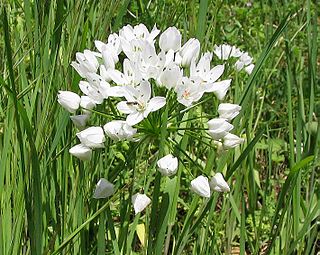
Allium neapolitanum is a bulbous herbaceous perennial plant in the onion subfamily within the Amaryllis family. Common names include Neapolitan garlic, Naples garlic, daffodil garlic, false garlic, flowering onion, Naples onion, Guernsey star-of-Bethlehem, star, white garlic, and wood garlic.

Cyperus eragrostis is a species of sedge known by several common names, including tall flatsedge, nutgrass, tall nutgrass, umbrella sedge, chufa, Earth almond, zula nuts, edible galingale and pale galingale.

Ribes aureum, known by the common names golden currant, clove currant, pruterberry and buffalo currant, is a species of flowering plant in the genus Ribes native to North America.
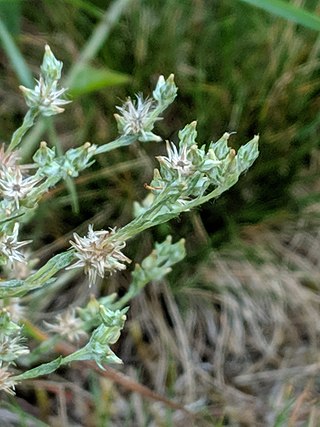
Logfia is a genus of herbaceous plants in the tribe Gnaphalieae of the family Asteraceae, known as cottonrose.
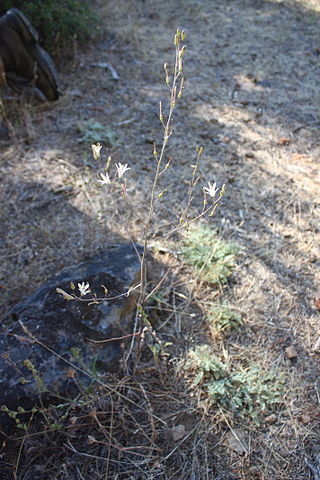
Chlorogalum angustifolium is a species of flowering plant, known by the common name narrowleaf soap plant.

Diplacus douglasii is a species of monkeyflower known by the common names brownies and purple mouse ears. It is native to the mountains and foothills of California and Oregon, where it is often found on serpentine soils. D. douglasii was first described in a published flora by George Bentham, an English botanist who was considered "the premier systematic botanist of the nineteenth century,." It was later described by Asa Gray, the father of North American botany.
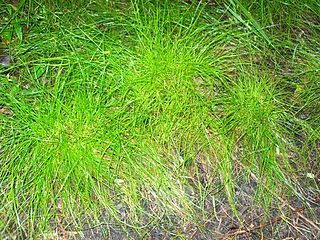
Cyperus gracilis, commonly known as slender flat sedge and slimjim flatsedge, is a species of sedge native to Australia. The species epithet gracilis refers to the graceful form of the leaves.
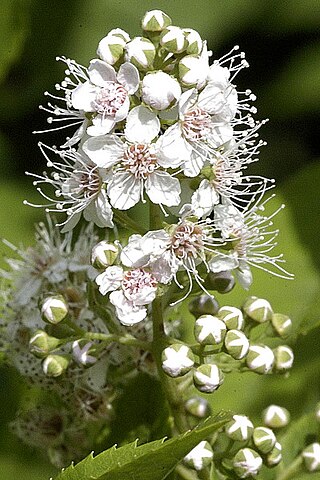
Spiraea alba, commonly known as meadowsweet, white meadowsweet, narrowleaf meadowsweet, pale bridewort, or pipestem, is native to the wet soils of the Allegheny Mountains and other portions of eastern North America, but is currently endangered in the state of Missouri. It is naturalized in other parts of the world.
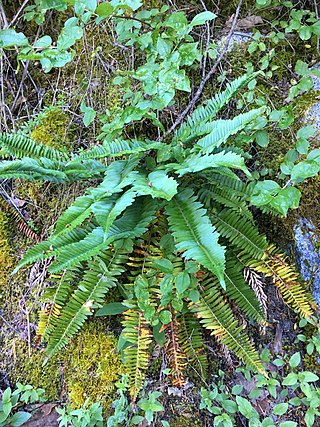
Polystichum imbricans is a species of fern known by the common names narrowleaf swordfern and imbricate sword fern. It is native to western North America from British Columbia and Idaho to southern California, where it grows in rocky soil and cracks in rock outcrops in coastal and inland mountain ranges and foothills.

Silene gallica is a species of flowering plant in the family Caryophyllaceae known by several common names, including common catchfly, small-flowered catchfly, and windmill pink. It is native to Eurasia and North Africa, but it can be found throughout much of the temperate world as a common roadside weed.

Wyethia angustifolia is a species of flowering plant in the family Asteraceae known by the common names California compassplant and narrowleaf mule's ears. It is native to the west coast of the United States from Washington to California, where it grows in grassland, meadows, and other open habitat. It is a perennial herb growing from a tough taproot and caudex unit and producing a stem 30 to 90 centimeters tall. The leaves have lance-shaped blades up to 50 centimeters tall. The inflorescence produces one or more large sunflower-like flower heads at the top of the hairy stem. The head has narrow, hairy phyllaries at the base. It contains up to 21 yellow ray florets each up to 4.5 centimeters long and many yellow disc florets. The fruit is an achene which may be nearly 2 centimeters long including its pappus.

Crepis tectorum, commonly referred to as the narrowleaf hawksbeard or narrow-leaved hawk's-beard, is an annual or winter annual plant between 30 and 100 centimetres in height. Originating in Siberia before being introduced to Canada in 1890, the narrowleaf hawksbeard's is an invasive species. Maintaining one branched, hairless and leafy stem during maturity, the narrowleaf hawksbeard has yellow leaves which are arranged in an alternate manner and less than 0.5 inches (13 mm) wide.

Hesperocyparis nevadensis is a species of western cypress tree with the common name Paiute cypress native to a small area in the Sierra Nevada Mountains of California in the western United States. It was formerly known as Cupressus nevadensis.

Arnica chamissonis, the Chamisso arnica, is a North American species of plants in the family Asteraceae. It is very similar to Arnica montana. Arnica chamissonis is native to North America and naturalized in parts of Europe while A. montana is indigenous to Europe.

Logfia filaginoides, also called herba impia or cottonrose, is a small annual plant in the family Asteraceae, found in the Southwestern United States.

Filago pyramidata, the broadleaf cottonrose or broad-leaved cudweed, is a European plant species in the family Asteraceae. It is native to the Mediterranean region of southern Europe, northern Africa, and the Middle East, plus Great Britain, the Low Countries, and Germany. It is also naturalized in scattered locations in North America and Australia, Pakistan, and other places.
Gamochaeta calviceps, the narrowleaf purple everlasting, is a species of flowering plant in the family Asteraceae. It is native to South America and to the southeastern United States (from Texas and Oklahoma to Virginia. It has also become naturalized in other places.



















